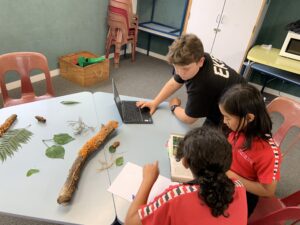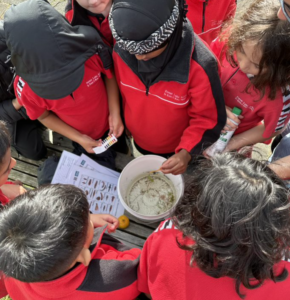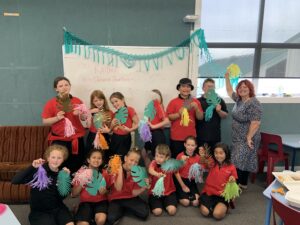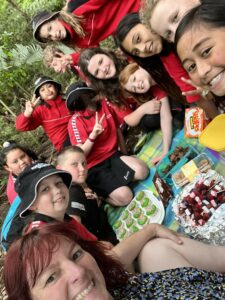Back at the end of 2022, I sat down with Whaea Natalie Friend, Enviroschools lead teacher at Forest Lake Primary in Kirikiriroa Hamilton, to reflect on the year and make plans for 2023. She wanted to encourage a shift in the whole school engagement but realised that this needed to be done in a way that was smart, to ensure that overburdened and stressed teachers felt like they weren’t being given something extra to do.
Three areas were identified as threads that would help weave the kaupapa through the school:
- setting up a Green team of students who would have a leadership role and work on projects that were important to them
- linking into the whole school inquiry which was the first line of the school pepeha “Ko Waikato te awa” and supporting mahi in the classrooms through a hands-on activity day at the awa
- develop a long term and aspirational goal of growing whole school involvement in Enviroschools and integrating the kaupapa throughout the school.
Whaea Natalie was given two days release each school term of 2023 and took the Envirogroup for one and a half hours a week during class time which enabled this mahi to happen. The following is a summary of what happened and her reflections. We have a good rapport, and she sends me voice messages with reflections on what’s happened which has enabled an ‘interview style’ for this case study. Forest Lake has a role of about 360 students which includes three Rumaki classes.
AG: So what’s gone well in 2023?
NF: Most things we wanted to achieve have happened or we’ve made movement on them. Often you have heaps of ideas, and you want to see change but you lack the time, resources or back up to do it. Number one, has been having a Green team that is functional. It’s easy to have kids join you for a lunchtime and do jobs, but having a team come together to make change with the intention – wanting to make bigger change than doing an activity has been massive. It was unexpected. They were so capable of running meetings and to have that experience of actually leading – the pride was huge!
The Green team was established as a unique group. Children had to apply and write why they wanted to be part of it. 12 students were selected from across the school and released from class to work together. If a student wanted to opt out, the group then considered other applications that hadn’t been successful originally. There was a real sense of responsibility and privilege to the job. Whaea Nat took on the role of quietly facilitating and guided and saw the students blossom and grow a sense of pride as they led their meetings and took turns at being Chair and Secretary, identifying their priorities and actions.
Weekly release time enabled Nat to give energy to enabling and empowering the group. She says she wouldn’t run an Envirogroup in a lunchtime again: “It’s just too difficult and you don’t get the results. It’s not what I want to do”.
The “Green team” now call themselves “Kaitiaki – Nature’s Guardians” and the name and purpose was the first thing that the group worked on together. Combined with team-building and sensory activities in the ngahere, it took them 5 weeks over the course of Term 1 to come up with their name, so it was a big moment of celebration! They also learnt about decision-making and how to operate effectively as a group.
NF: “What I really liked and am proud of was how they [ākonga] learnt to make decisions as a group. They looked at the various options starting with the Decisions, Decisions activity from the Enviroschools Kit. They looked at consensus decision-making and power balance decision-making, and how to enable everyone to have a voice. It’s important if someone doesn’t quite agree and needs more discussion, they don’t just get bowled over by majority rules. I really love that they’ve got that skill of communication. If someone doesn’t agree, they know it’s not personal. The group is having a discussion about something, and everyone can have a turn and be heard. I didn’t realise how capable they would be, that level of communication. I’m really proud of that. What I see is a group of contributing citizens with good communication skills that they are continuing to develop. It’s something that older generations can lack because we’ve grown up with such a top-down approach, and I’ve had to learn it for myself.

Developing observation and identification skills.

Working on plant and fungi identification.
Other achievements for the group, included identifying and learning about the native trees in the Ngahere, a small but significant stand of kahikatea trees planted in the 1920s. They were presented with the opportunity to lead a tour for visitors as part of the school’s Matariki evening, but due to bad weather, this was postponed till a few weeks later and during the school day. You could see the confidence of the children.
“I’m really proud how they learnt how to lead a tour. They took students, whanau and adults including the principal. They had confidence within a pre-existing power structure is really impressive” says Whaea Natalie.
The group realised having permanent signs in the ngahere was important, and asked Whaea Natalie and me (Facilitator Adrienne) to help them with a funding application to the Waikato Enviroschools Fund. This was successful and will enable the signs to be one of their action projects for 2024. The Kaitiaki – Nature’s Guardians also designed and had made their own unique Kaitiaki -Nature’s Guardians badges to be sewn on to their school shirts.
“This was so big for them – to see the end product. They are super proud. It’s low hanging fruit, but it gives something tangible that they have completely owned,” says Whaea Natalie about the badges.
They also identified bigger projects to drive in the school. They recognised an opportunity with the current school vegetable gardens and an adjacent container that could become a central “Enviro-Hub”. It’s a place that gets a lot of foot traffic, but the gardens are currently mostly maintained by the caretaker Matua Matt, with support from children at lunchtime. They had lots of ideas including a ‘clubhouse’, outdoor seating and tables, a potting up area, a grape-vine shelter, chickens and permanent compost bins. They were invited by the principal to share their vision to the Board of Trustees which they did. The Board was supportive and asked them a lot of questions. Their next steps include consulting with the school community and further developing plans. It will be a significant project that they will work in in 2024 (and beyond).

Testing pH and checking for aquatic macro-invertebrates next to the awa.

Using the Waikato River walkway near the school to experience, observe and measure.

Mapping the Waikato awa.
Ko Waikato te awa, the first line of the school pepeha was the focus of a whole school inquiry for 2023. After a staff meeting in Term 1 exploring the Enviroschools Water of Life Theme Area to support inquiry planning, we organised field trips to the Waikato awa for each middle and senior school hub during Term 2. The field trip enabled students to become more physically connected to the awa by looking at water clarity, habitat, macro-invertebrates and human impacts on water quality. On the 20-minute walk back to school they were asked to look out for storm water drains and imagine what water might pick up as it travelled down the gutters through drains to the river. They also picked up any litter that they found. The experience provided teachers with multiple avenues to explore with their classes and at the end of Term 4 each hub had a student showcase, sharing their learnings with whānau. While each hub ran their inquiry and showcase differently, Whaea Natalie shared her experience:
“It was amazing! There wasn’t enough space for whānau! Students stood in front of their massive Waikato Te Awa painting and shared and reflected on the learning that they had done for the whole year. They did a performance of “The River that ran Away”. The whole inquiry integrated drama, art, science, social science and science, ultimately looking at how through how to protect our rivers.” – Whaea Natalie
As the 2024 school year started, Whaea Natalie was given the news that she will have 1 day of release a fortnight to work on Enviroschools. This includes working with the Envirogroup and continuing to support teachers with resources and ideas. It shows a real commitment to grow and develop the work that has been done. The third thread, growing whole school involvement in Enviroschools and integrating the kaupapa through the school is evolving. A well supported lead teacher has raised the profile and opportunities of Enviroschools in the school. A lot of work and passion has made this shift happen; but the key change has been a commitment from senior management.
“Having a unit and release time has made all the difference. It goes to show that you can all the passion, but if you haven’t got the time, no amount of passion can make it a reality. Because I’ve been given the time to do it, my passion can come through. That’s been essential.” – Whaea Natalie

Time to reflect and celebrate great things!

Sharing kai at the end of year.